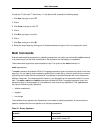
Recorded Macros
There are two types of macros in SlickEdit® Core: macros that you record, described below, and macros
that are available for programming (see Programmable Macros).
You can automate repetitive tasks by recording a series of SlickEdit Core operations in a macro. After you
create a macro, you can run it, save it, bind it to a key sequence, and/or modify the macro’s source code.
Recording a macro generates Slick-C® code for performing the action being recorded. Therefore, record-
ing a macro is also a useful way to discover and implement Slick-C code that controls the behavior of
SlickEdit Core. See Using Macros to Discover and Control Options for information.
Recorded Macro Operations
Macros can be recorded, executed, and saved from the Macro menu, or you can use commands or pre-
defined key bindings to perform macro operations:
• To start or end macro recording, from the main menu, click Macro → Record Macro or Macro → Stop
Recording Macro, respectively. Alternately, you can toggle recording on and off with one of the follow-
ing methods:
• Click the recording indicator REC, located along the bottom edge of the editor. When a macro is be-
ing recorded, the recording indicator is active (not dimmed).
• In CUA emulation, press Ctrl+F11 (the key binding associated with the record_macro_toggle com-
mand).
• On the SlickEdit Core command line, type record_macro_toggle.
See Recording a Macro for more information.
• To run the last macro that you recorded, click Macro → Execute last-macro, press Ctrl+F12, or use
the record_macro_end_execute command. See Running a Recorded Macro for more information.
• To display a list of your recorded macros, from which you can edit, run, delete, or bind to a key se-
quence, click Macro → List Macros, or use the list_macros command.
Note
List Macros only shows your "saved" macros, not your last recorded macro or macros created us-
ing execute_last_macro_key.
Recording a Macro
To record a macro, simply start the recording, enter the keystrokes you want to record, then end the re-
cording. The instructions below outline the steps.
Recorded Macro Operations
330


















